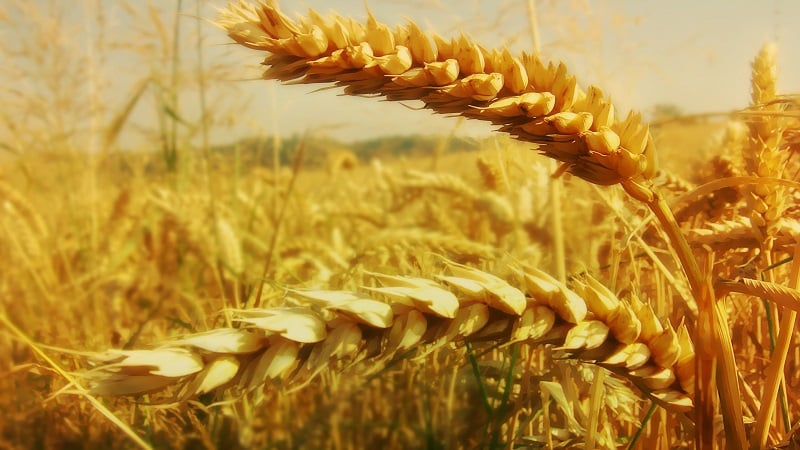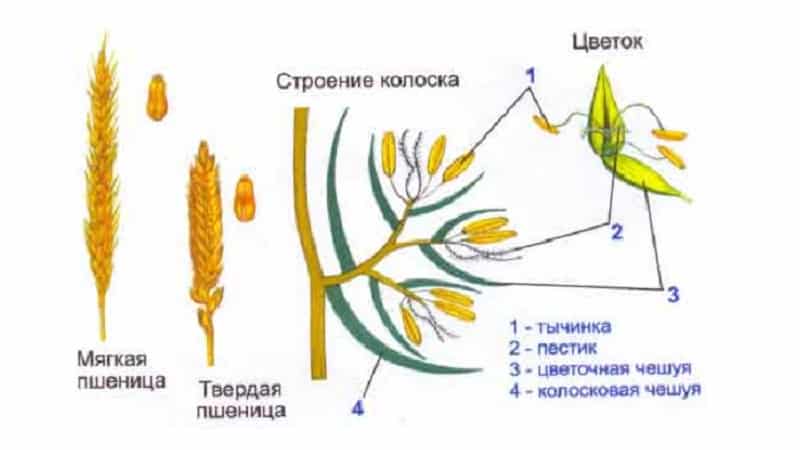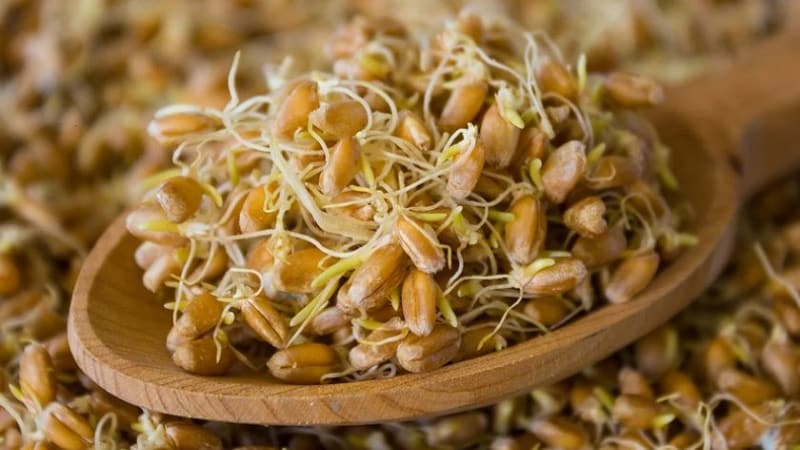Ear of wheat - structure, botanical description and features
Wheat has accompanied man since ancient times. In gratitude, people place the ear of this cereal on numerous coats of arms, for example, in the USSR before and in the Orenburg region now. Wheat - not only a source of life, but also a symbol of fertility in many cultures of the world. The grain ear has an amazing structure and a wide variety of shapes.
What is an ear of wheat
Human domesticated this crop back in the Neolithic age. The earliest people probably ate unripe grains of wheat, since upon reaching maturity it crumbled and could not be harvested.
Over time, under the influence of weather and climatic conditions and random thousand-year selections, varieties appeared within ancient species that were susceptible to harvesting. Ancient wild wheat was called einkorn and spelt, from which porridge was prepared in Rus'. And here for flour production it is no good - it is difficult to grind.
Spelled – one of the most useful types of wheat. It has fragile ears, but it surpasses all other varieties in terms of fiber, protein, fat and vitamin content. Adherents of proper nutrition often use spelt to prepare porridges.
Important! Thousands of years of selection have led to the fact that without humans, wheat is not able to reproduce independently.
Scientists have discovered spelled grains in the tombs of Egyptian pharaohs that fully correspond to the varietal characteristics of modern ones.Historically, the most widespread cereal in our time comes from Southern Europe, North Africa and Asia Minor. Today, 70% of all arable land on the planet is sown with it.
An ear of wheat is an inflorescence characteristic of angiosperms. It consists of many flowers planted on an elongated main axis.

What a spike of wheat looks like can be seen in the photo.
Grouping of wheat spikelets
Cereal happens spring And winter, one- and two-year-old, grains – soft and hard. Different varieties of wheat have different spikelet structures.
Botanical
Biologists classify spikelets according to size and shape.
Divided by length:
- in soft wheat – into small (up to 8 cm), medium (8-10 cm) and large (more than 10 cm);
- at hard – short (up to 6-7 cm), medium (7-8 cm), elongated (8-10 cm) and large (more than 10 cm).
Spike length may vary in plants of the same variety under the influence of weather and climatic conditions, soil and agricultural technology.
Important! The most popular type of durum wheat is durum. It is used to make couscous and flour for pasta, pizza, and dumplings.
The shape of the spikelets is:
- club-shaped - widen towards the apex;
- spindle-shaped - the middle part of the ear is the widest, tapering towards the top and base;
- prismatic - almost the same thickness along the entire length.
In cross section, the ears are rectangular, square, oval and round.
Spikelet varieties
Currently The most common types of wheat are durum and soft..
Ear of durum wheat:
- awned, sometimes awnless;
- The awns are longer than the ear and parallel to it;
- scales without wrinkles or depressions;
- the rod is covered with spikelets;
- The grain is round-triangular in cross-section, glassy, elongated, very large.
Bread wheat varieties are more commonly grown because they are easier to harvest with combines. It does not crumble, losses during harvesting are minimal, and the grain is well stored.
Important! The stem of the cereal can grow up to 1.5 m, and one plant produces up to 12 stems.
Ear of soft wheat:
- prismatic spinous or spineless;
- awns are shorter than the ear or equal to it;
- scales with characteristic longitudinal wrinkles are depressed at the base;
- the stem is not covered by spikelets;
- The grain is mealy, short, round in cross section.
In addition to soft and hard, the world cultivates English varieties of wheat, dwarf, Polish and spelt.

Structure of an ear of wheat
A wheat ear reaches 4-15 cm in length depending on the variety. The spike scales do not exceed 6-15 mm. The grain's ears are single, tightly adjacent to the axis in two identical rows (from 5 to 18 mm), each of which has from 2 to 7 close flowers. The flower consists of 2 scales, 2 films, 3 stamens, 2 stigmas and one pistil.
Important! From unripe green wheat grains, freekeh grains are made by roasting over an open fire, a popular food for diabetics.
What does it consist of?
The ear is a continuation of the cereal stem. It includes a jointed rod and spikelets located on its ledges. The narrow side of the rod is called the side, the wide side is the front. On each ledge there is one spikelet, which consists of two glumes and flowers. An apical spikelet grows at the end of the rod.
Important! Wheat is used to produce not only flour, but also cereals. In our country - millet and semolina, in the Middle East - bulgur, in the Mediterranean - couscous.
How many grains are in one ear of wheat?
This cereal one ear contains up to 16-22 spikelets depending on the type and variety. Each spikelet has 2-3, sometimes 4-5 flowers that produce grain. All other flowers either do not develop or do not produce grain. With proper agricultural technology, the maximum number of grains in a spikelet reaches 8.
Important! In the Russian Federation, an ear of wheat with 45 grains is considered average. In Europe, an ear yield of 60-80 grains is the norm. In our fields, European varieties produce such yields only for 2-3 years, then the wheat begins to produce the usual 45 grains.
Where are spikelets used?
In addition to traditional processing into flour, medicines are made from grains, spikelets are used to make bouquets, threshing waste is used as food for livestock.
In medicine
“Cholef” extract is prepared from the germ of the cereal., which is intended for patients with muscle dystrophy. “Mitroshin Liquid” is prepared from the grain for the treatment of lichen, eczema, neurodermatitis, and sycosis.
The grains are processed into oil, which is rich in B vitamins and tocopherol. This drug is prescribed to treat burns, psoriasis and eczema. In cosmetology, it is recommended for strengthening hair and treating stretch marks in the postpartum period.
In folk medicine, remedies are prepared for internal and external use. from bran, grain decoction and sprouted seeds.

In floristry
Experienced and novice craftsmen make beautiful wreaths, bouquets and compositions from spikelets of cereal involving various elements. To add variety to the decor, the spikelets are painted in bright colors.
The trend is to decorate wedding tables, place cards and invitations for guests with small sheaves of spikelets. They are used to make jewelry and children's toys.
Important! In floristry, wheat is usually called by its Latin name - Triticum.
In animal husbandry
According to experts, up to 90% of all wheat cultivated in the world is wasted for livestock feed. These are grain, haylage, straw and green mass.
Conclusion
The ear of bread is distinguished by its beauty and grace due to its natural structure. Spikelets grown in the vast expanses of our country contain, as a rule, 45 grains, and European ones - up to 80. Soviet breeders developed varieties with a yield of over 100 seeds, but these developments were not preserved.
Spikelets are used not only for the production of flour, bread and cereals, but also in cosmetology, medicine, decoration, and livestock farming.
Everything is wonderful, only they make semolina and wheat grits from grain, but not millet. Millet is millet, but this is a different grain.